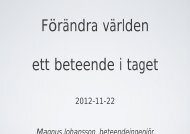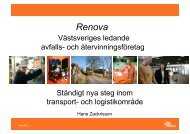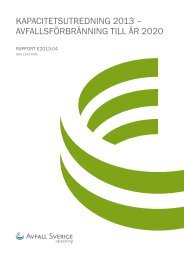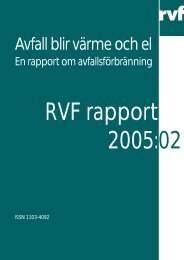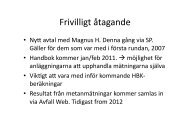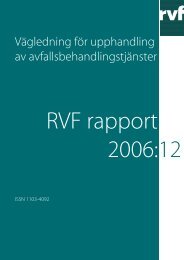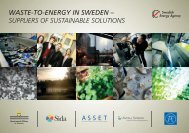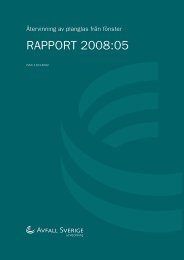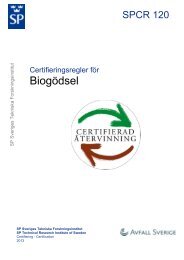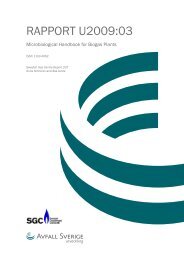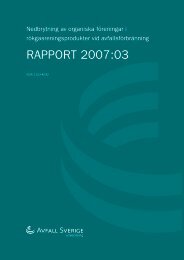SWEDISH WASTE MANAGEMENT |2010 - Avfall Sverige
SWEDISH WASTE MANAGEMENT |2010 - Avfall Sverige
SWEDISH WASTE MANAGEMENT |2010 - Avfall Sverige
Create successful ePaper yourself
Turn your PDF publications into a flip-book with our unique Google optimized e-Paper software.
<strong>SWEDISH</strong> <strong>WASTE</strong> <strong>MANAGEMENT</strong> 2010<br />
<strong>WASTE</strong> FROM ELECTRICAL AND ELECTRONIC EQUIPMENT (WEEE)<br />
In 2009, 143,850 tons of waste from electrical<br />
and electronic equipment – the abbreviation<br />
WEEE – was collected, which is a decrease<br />
of 5.2 percent compared to 2008. On average,<br />
15.4 kg WEEE per person was collected in<br />
2009, compared to 16.3 kg per person the<br />
year before. There are close connections<br />
between economic situation, consumption<br />
and waste production. The reduction is therefore<br />
likely to be a result of the recession and of<br />
smaller and lighter electric and electronic<br />
products.<br />
Since the producer’s responsibility was<br />
taken into effect in Sweden, local authorities<br />
and producers have cooperated in the management<br />
of WEEE. Together, <strong>Avfall</strong> <strong>Sverige</strong> –<br />
Swedish Waste Management, the Swedish<br />
Association of Local Authorities and Regions<br />
(SALAR), and the electrical producers’ service<br />
company, El-kretsen, created the system in<br />
2001. The collaboration means that local<br />
authorities assume responsibility for the collection<br />
of electronic waste from households,<br />
and the producers are responsible for its treatment.<br />
Collection of electronic waste from households<br />
is primarily carried out at the manned<br />
municipal recycling centers, of which there are<br />
approximately 600 throughout the country. In<br />
some municipalities this is complemented by are incinerated in waste-to-energy plants, and<br />
curbside collection. <strong>Avfall</strong> <strong>Sverige</strong> – Swedish metal is recycled in smelting plants.<br />
Waste Management and El-Kretsen collaborate<br />
with several local authorities on different<br />
projects to develop these collection systems.<br />
An example of this is the collection of light<br />
bulbs and smaller electric and electronic waste<br />
into small containers, which are placed in<br />
stores and other public places.<br />
WEEE is pretreated through sorting and dismantling<br />
before it is sent on for further treatment.<br />
Pretreatment is carried out in certified<br />
facilities, and later forwarded to final treatment<br />
or recycling.<br />
Components containing hazardous substances,<br />
i.e. hazardous waste, are treated in<br />
approved treatment facilities. Plastic casings<br />
Fluorescent tubes and low-energy bulbs contain<br />
mercury. These products are therefore<br />
separated and treated in a closed process. The<br />
glass and metal contents are recycled, and<br />
methods enabling the recycling of the phosphorus<br />
powder with its mercury content, is<br />
being developed.<br />
It happens that old electronic products are<br />
donated to other countries as charity, for what<br />
may seem as a good cause, but this is however<br />
not environmentally friendly. From an environmental<br />
point of view, it is better to have these<br />
products recycled in Sweden, where we have<br />
methods to treat such waste in an environmentally<br />
sound way.<br />
COLLECTION OF WEEE 2003-2009<br />
tons<br />
200,000<br />
150,000<br />
100,000<br />
50,000<br />
0<br />
-03 -04 -05 -06 -07 -08 -09<br />
Återvunnet elavfall<br />
13



